2 Biomes
A biome is a group of terrestrial (land-based) ecosystems with similar climates and vegetation structures. Vegetation structure refers to the relative abundance and spatial patterns of trees, shrubs, and grasses (growth forms of plants). An example of vegetation structure that is distinctive and occurs in at least two global biomes is savanna, with scattered trees and shrubs and an understory formed by grasses (Figure 1).

Both vegetation structure and the global distribution of biomes are related to climate, although we’ll also look at other factors influencing vegetation structure. Figure 2 is a simple diagram relating vegetation structure to the range from wet to dry climates. Figure 3 illustrates the distribution of biomes with latitude (mostly related to temperature) and from wet to dry climates.


Figure 4 is a generalized map of showing the distribution of major biomes. “Generalized” mainly means simplified, when applied to a map like this. The boundaries between biomes are simplified, small isolated areas occupied by a biome are not shown, and areas that don’t fit well in one or another of the biomes are also not shown. A good example of the last kind of area is mountain ranges where vegetation is often quite different than surrounding lowlands. As we discuss each biome, you can refer back to this map to see where it occurs.

For each biome, we’ll discuss its climatic setting, its vegetation structure, typical soil orders, examples of typical adaptations to environmental conditions in that biome, and the role of fire or other disturbance in that biome.
Tropical Rainforest
The tropical rainforest biome occurs in wet tropical climates, characterized by high temperatures and rain throughout the year, though generally with more rain in some seasons that others. This biome is dominated by forests with large trees, high NPP, and high biodiversity (high numbers of species of plants and animals) (Figure 5). Because of the large trees and the large land area occupied by this biome, much of the total pool of carbon in terrestrial biomass is stored there. Soils in this biome are generally Ultisols or Oxisols, with some Spodosols on sandy parent materials and extensive Histosols in wetlands. Because of the lack of strong seasonal contrasts in temperature or moisture, trees in tropical rainforests are more likely to be evergreen (leaves fall in small numbers through the year so the tree is always green) rather than deciduous (most leaves fall at the same time and there is a season when the tree does not have leaves). Note that “evergreen” as used here does not refer to needle-leaved, cone-bearing trees, as it often does in the US; most tropical evergreen trees are broadleaved.
Two interesting adaptations of plants in this biome are represented by buttress roots and epiphytes (Figures 6). Buttress roots are an adaptation that stabilizes large, tall trees with shallow root systems. Because in many tropical rainforest soils the nutrients available to plants are concentration in a thin A horizon, tropical rainforest trees can have large but shallow root systems. Buttress roots help stabilize shallow-rooted trees during wind storms. Epiphytes are plants that grow on other plants, usually trees. Often they grow from cavities on tree branches that trap some water, organic matter, and dust, forming a kind of soil.


Wildfire and other forms of disturbance not directly related to human activity are rare in tropical rainforests, with one important exception: Hurricanes/typhoons/cyclones (all the same kind of storm, as covered in a later course module) can cause extensive wind disturbance to tropical forests that lie in their paths. Human disturbance is widespread and is a major environmental issue in many parts of the tropics. This disturbance can include logging (Figure 6) or deliberate burning and replacement of the forest by planted crops, including tree crops like oil palms or eucalyptus trees used to make paper.

Monsoon Rainforest and Dry Tropical Forest
Tropical forests that have distinct dry seasons and generally lower rainfall that tropical rainforests are widespread (all are grouped together on the map in Figure 4). Monsoon rainforest is found in the wetter parts of regions that have monsoon climates. They have a dry season but still receive significant rainfall, overall. There are also dry tropical forests in the rainshadows of mountain ranges (rainshadows are covered later in the course). There are good examples of dry tropical forests in Hawaii, Puerto Rico, and Central America; these have received quite a bit less scientific study than tropical rainforests. Soils of monsoon rainforests and dry tropical forests include Ultisols, Alfisols, and Oxisols, with Andisols in some areas where the soils are formed in volcanic ash. The generalizations about disturbance in tropical rainforest also apply here.
Tropical Savanna
Tropical savanna is a very widely distributed and important biome (see map in Figure 3), and is widely believed to be the original home of the human species. “Savanna” refers to the vegetation structure, with scattered trees and an understory of grasses. There are many local and regional variations in this pattern and in the general appearance of tropical savannas (Figures 8 and 9). There are also areas of grassland with few if any trees within the tropical savanna biome (Figure 10). Tropical savanna occurs mainly in regions with monsoon climates. The monsoon climograph of Ndjamena (Figure 11) that we looked at earlier is from the region of Africa called the Sahel, a kind of transition zone from tropical savanna to desert. Much of the tropical savanna biome has a dry season a little less extreme than Ndjamena, but still very distinct. Soils of tropical savanna are mainly Alfisols and Ultisols, as well as Vertisols in low areas with clay deposits. Mollisols are rare, even in the grasslands within this biome.



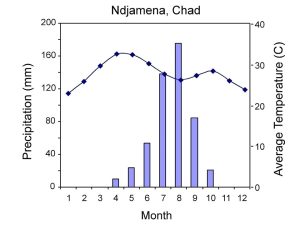
Disturbance by fire and herbivory (animals feeding on plants) are very important in tropical savanna, in fact, by many accounts the biome wouldn’t exist without this frequent disturbance. Fire is or has been common in most if not all tropical savannas, set by people or ignited by lightning, particularly in the dry season when the grasses are more flammable (Figure 12). The deliberate use of fire by Indigenous people for many different purposes is well-documented for some tropical savannas, in northern Australia for example, although tropical savanna existed and experienced fire before the emergence of modern humans. Fire generally favors grasses, maintaining the open vegetation structure of savannas. Grasses can regrow from a growing point that is at or below the soil surface and survives fires, and have a large belowground biomass (Figure 13). Some grass species are especially well-adapted to frequent fires. Trees and shrubs have less of their biomass below ground and growing points along stems and branches and they are much more likely to be killed or have their growth set back considerably by fires.
Herbivory can be by wild animals or domestic livestock. Many grazing animals feed preferentially on grasses, which can then be set back in their growth relative to trees and shrubs that are less palatable to herbivores, so herbivory can potentially favor trees and shrubs over grasses. On the other hand, a variety of wild animals and domestic goats often feed on leaves and stems of trees and shrubs. There is also a widely held view, though still somewhat controversial, that herbivory can stimulate additional growth by grasses, so grass biomass is greater when there is a moderate amount of grazing than when there are no grazing animals present. Overall, the effects of herbivory are more complex and controversial than the effects of fire in tropical savanna. One clear effect of herbivory is that many tropical trees and shrubs have developed adaptations such as thorns that protect them from browsing by animals.
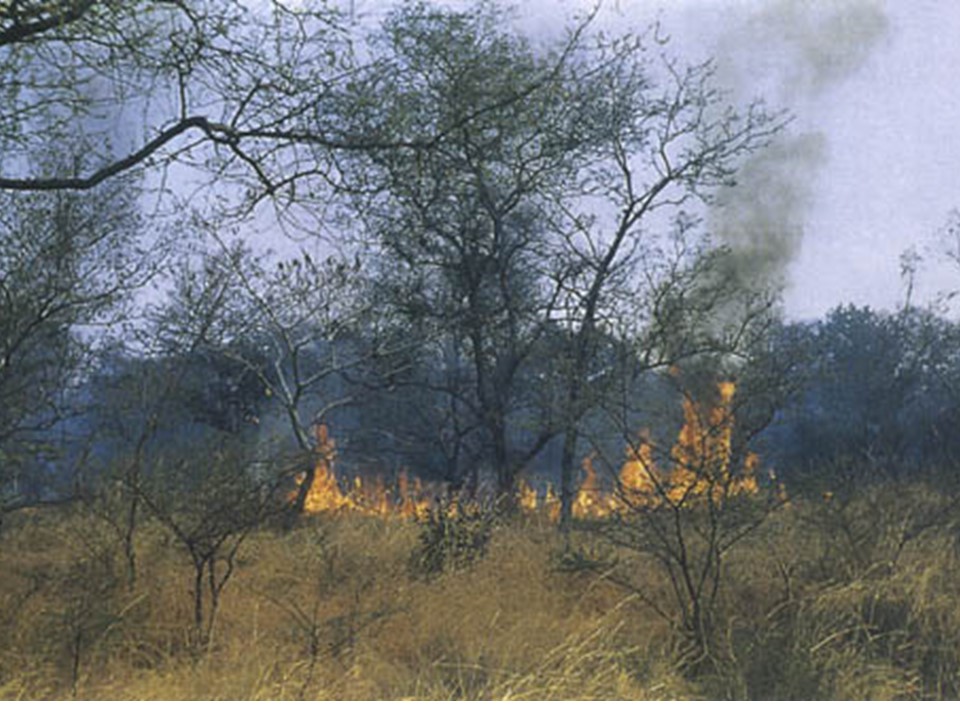
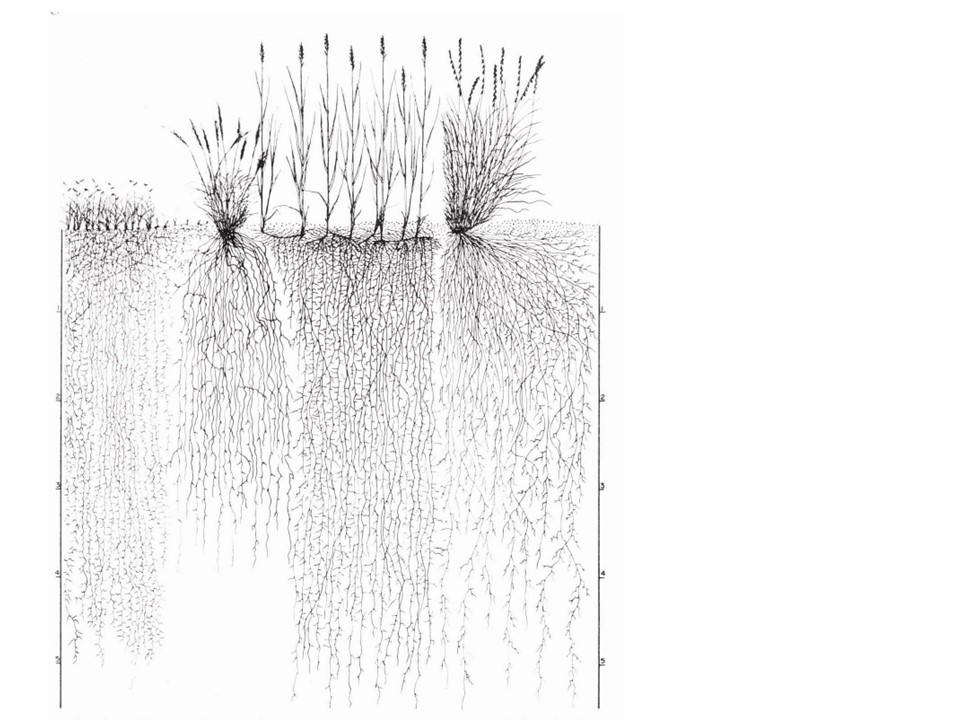
Desert
A look at the map in Figure 3 will show that many of the world’s deserts are located in the subtropics, centered around 30º North or South latitude. At these latitudes, air descends from higher levels in the atmosphere, suppressing rainfall and creating very dry climates (more on this later in the course). Deserts also occur at higher latitudes in the rainshadows of high mountain ranges. The desert biome is generally thought to have low biodiversity, but in fact there is a wide range from desert landscapes dominated by only one or two plant species (Figure 14), to those where many species grow together and species diversity is relatively high (Figure 15). Common soils in the desert biome include Aridisols, Inceptisols, and Entisols.
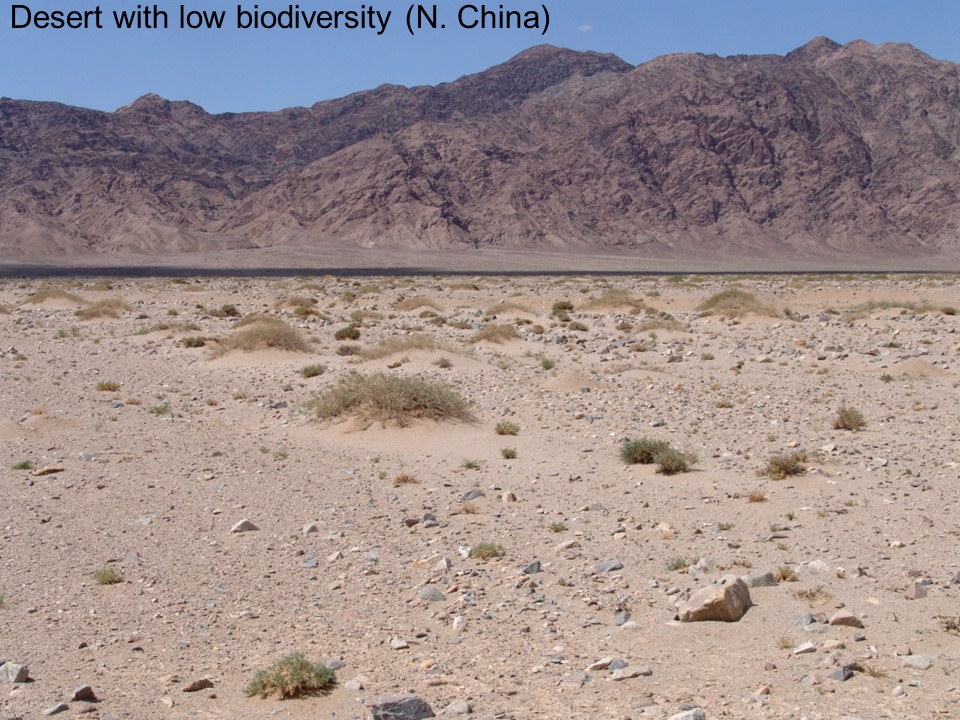
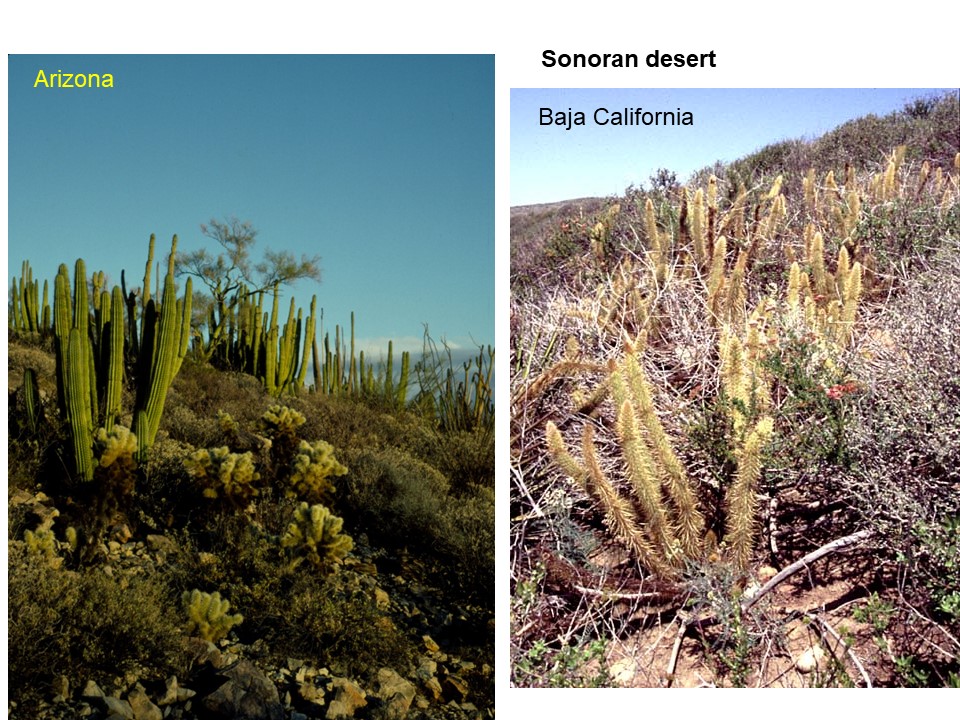
Desert plants have many adaptations to the low availability of soil moisture because of low precipitation. Some are succulents, able to expand their stems to store water when it is available after rainy periods. Cacti, which are native to deserts in North and South America, use a special form of photosynthesis that allows them to lose less water while taking in carbon dioxide. Shrubs like creosote brush lose their leaves and are dormant for long periods when there is little water in the soil. Finally, there are many desert species that emerge and flower only in years of unusually high rainfall, creating rare “desert blooms” that attract many people to see the landscape covered in flowers for a brief period of time (Figure 16).

Disturbance by fire is rare in deserts because the sparse vegetation offers only a limited amount of fuel. Desert valleys are disturbed by rare flash floods that erode stream channels and flood low parts of the landscape. Disturbance through grazing by domestic sheep and cattle is common in many deserts.
Mediterranean Biome
The Mediterranean biome includes distinctive ecosystems with many plants adapted to dry conditions during the high sun season, and its distribution corresponds closely to the areas with Mediterranean climates. Many plant species occur only in specific areas of the Mediterranean biome, creating clusters of relatively rare species (areas of the Mediterranean biome in South Africa are a particularly good example-see Figure 17). Plants in the Mediterranean biome are mostly shrubs and small trees, with adaptations to limit water loss such as small leathery leaves (Figure 18). Many Mediterranean plants produce volatile oils that impart a distinctive smell to the landscape. Well-known herbs such as thyme, rosemary, and lavender are good examples; all grow wild in the Mediterranean biome of southern Europe. Soils of the Mediterranean biome include Alfisols, Inceptisols, and Entisols.


Fire is a common form of disturbance in the Mediterranean biome. The volatile oils that make Mediterranean plants aromatic also make them highly flammable. In southern California, devastating fires occur when strong “Santa Ana” winds blow through the local Mediterranean vegetation, called chaparral. Similar fires occur in the Mediterranean biomes of southern France and Italy. There is some debate about how frequent fires were in the California chaparral before 20th century population growth increased the number of fires set accidentally by people (and their cars, etc.). It appears that fire frequency is increasing with more frequent drought in many areas of this biome.
Temperate Forest
Temperate forest is widespread in the wetter parts of the midlatitudes of the northern hemisphere, and occurs in smaller areas in the southern hemisphere. Climates of Charlotte, North Carolina, Madison, Wisconsin, and Portland, Oregon, all discussed earlier in class, are good examples of the climatic conditions typical of this biome. Temperate forest occupied much of northern and eastern Wisconsin prior to the late 1800s, along with large parts of the Midwestern and eastern United States. Natural vegetation across much of Europe, central China, Korea, and Japan belongs in this biome as well. Some temperate forests are dominated by conifers, others by broadleafed trees, and still others have a mixture of the the two (Figure 20). Soils of the temperate forest include Alfisols, Inceptisols and Ultisols, with smaller areas of other soil orders.

Temperate forests generally have lower biodiversity than tropical forests. An interesting observation is that, while different species occur in the temperate forests of North America, Europe, and Asia, there are many examples of very similar-looking trees growing in all three. Figures 21 and 22 show an example: two very similar species of “tulip trees,” (Liriodendron sp.), in eastern North America and East Asia.
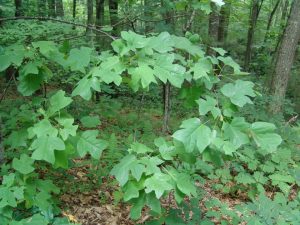
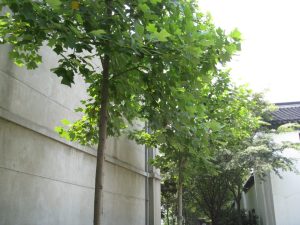
One of the most important adaptations of broadleafed trees in temperate forest is the seasonal loss of leaves, making them deciduous. It is widely believed that this adaptation first developed in dry tropical forests, because of limited moisture in the dry season. In temperate forests, it serves the purpose of preventing the loss of water in winter, when soils are frozen and roots cannot extract water from them.
Windstorms are a common form of disturbance across the temperate forest biome. In many temperate forests, the ground surface is covered with pits and mounds produced when trees are tipped over and uprooted by the wind. The tree roots pull up soil to form a pit. The soil then falls off or is washed off the roots by rain and forms a mound next to the pit. The importance of fire as a a disturbance varies widely across this biome. Some temperate forests are adapted to frequent fires (Figure 23) while others experience them only every few hundred to a thousand years (Figure 24).


Many temperate forests in Europe and Asia have a very long history of human disturbance in the form of logging and clearance for agriculture. Areas used in the past for agriculture or settlements have returned to forest in some cases, especially in recent years. In North America Indigenous use of fire and other practices altered forests, but except in river valleys, most were not extensively cleared until European settlement in the 1700s and 1800s. In the 1800s to early 1900s, widespread logging occurred across much of the temperate forest in the Midwest and eastern US. Now, in places like Wisconsin, “second-growth” forests have regrown after logging. In all of these places, the forest that returns after human disturbance is not identical to the one that existed previously. Some tree species and understory plants are more common, while others have disappeared.
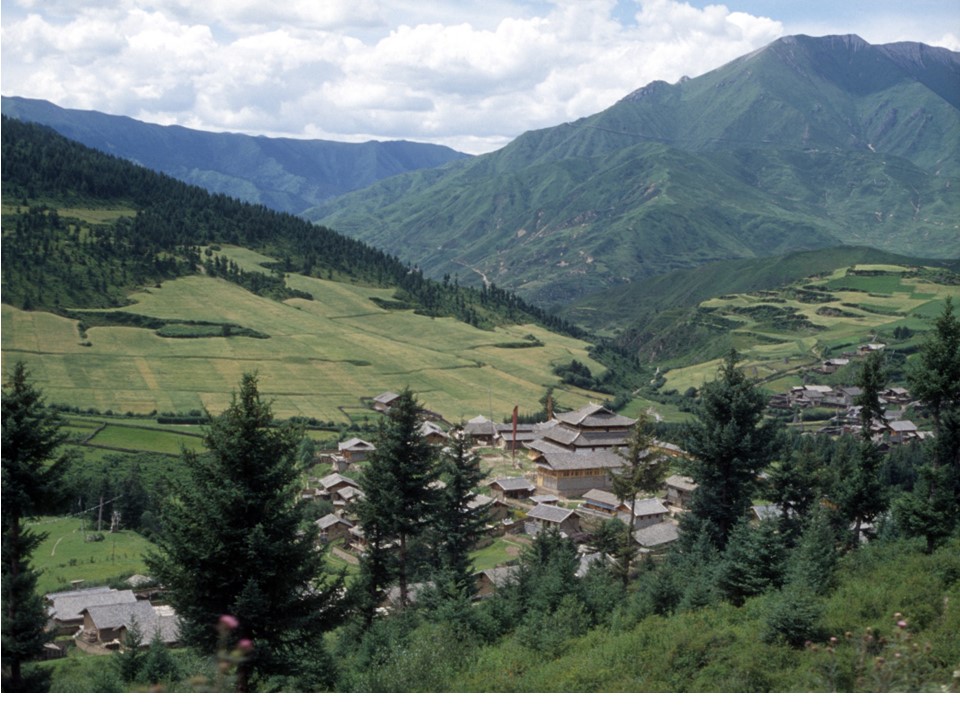

Temperate Grassland
The temperate grassland biome occurs in drier parts of the midlatitudes, often in the interior of continents, far from ocean moisture sources. The climograph of Williston, North Dakota, discussed earlier, is typical of this climatic setting (Figure 27). Regions that exemplify this biome include the grasslands of the Great Plains in the US and Canada, and the steppes of southern and eastern Ukraine, southern Russia, Kazakhstan, and Mongolia (Figures 28 and 29). The vegetation structure in temperate grassland is dominated by perennial grasses, but scattered shrubs are also present as well as trees along rivers. Soils of temperate grasslands are often Mollisols, although Entisols and Inceptisols occur in more rapidly eroding parts of the landscape, and Alfisols are present in relatively dry and warm grassland. Mollisols of temperate grasslands store large quantities of organic carbon, especially in cooler climates.
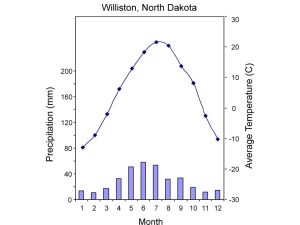
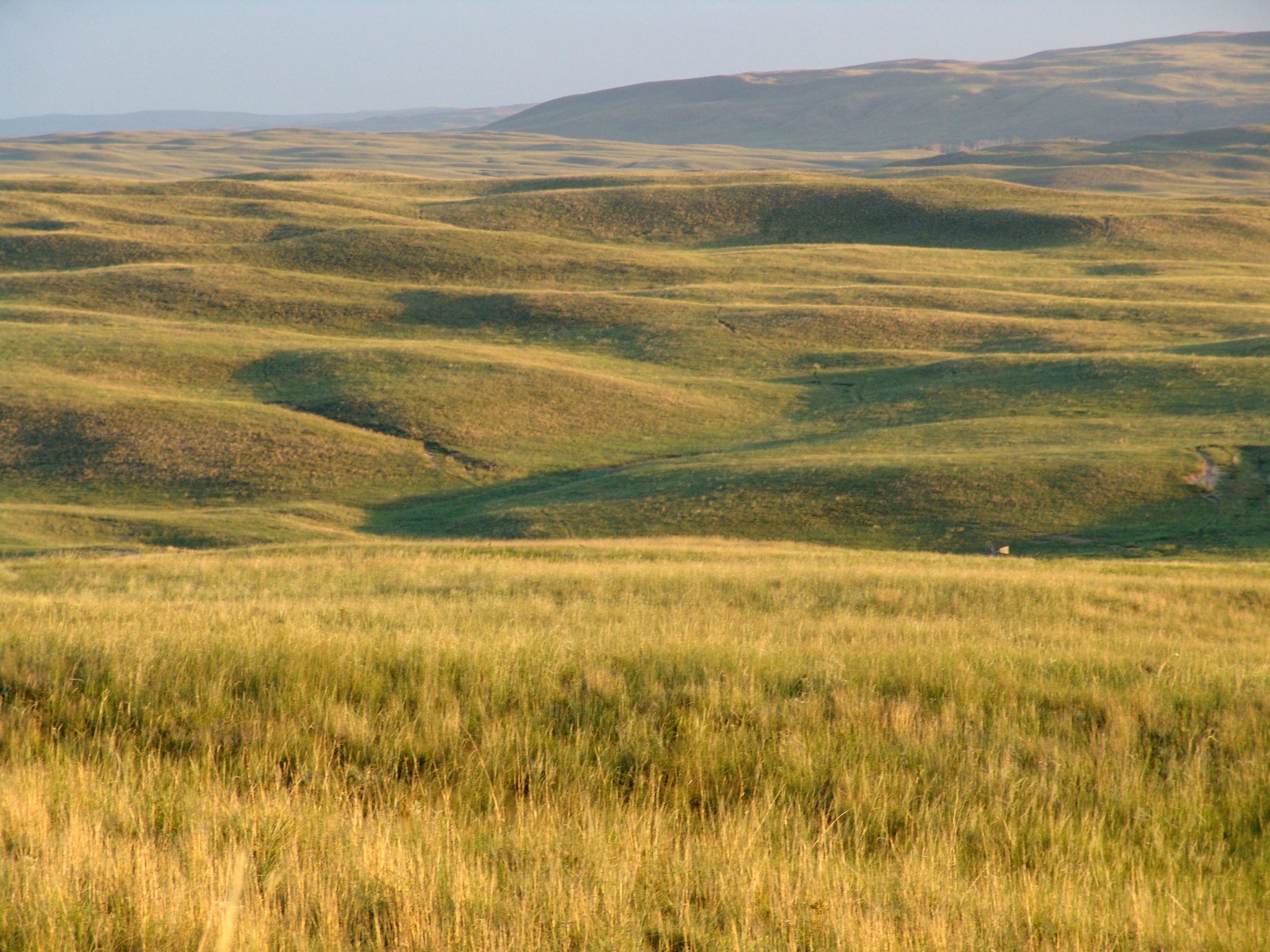
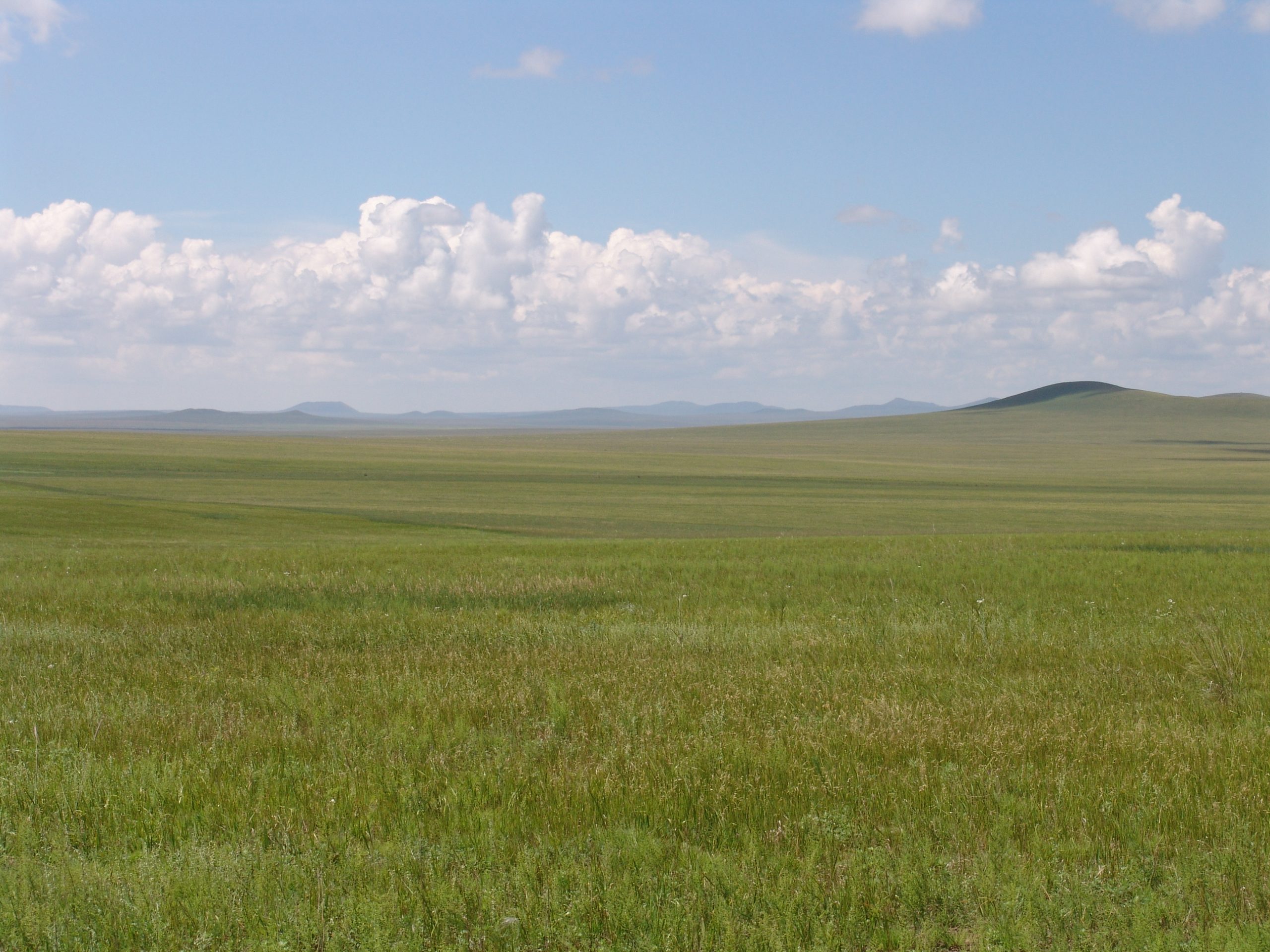
Temperate grasslands are maintained in part by fire, which is more important toward the wetter edge of the grasslands where they border on temperate forest. As discussed earlier for tropical savanna, grasses are able to survive fire to a much greater extent that trees and shrubs. The common grass species in areas like the Great Plains are also adapted to frequent drought, going dormant until moisture returns. Warm season grasses, which grow and flower in the warmest part of the summer, use a distinctive form of photosynthesis that allows high productivity at high temperatures (corn is a warm season grass with this adaptation, though a domesticated one). Cool season grasses, which grow and flower in early to mid-summer, are better adapted to colder climates such as the northern Great Plains. In the Great Plains, grasses common toward the east are tall and flourish in the higher rainfall there. Short grasses are more abundant toward the west, where it is drier. There are similar variations in grass size and warm season/cool season proportions in other temperate grasslands.


Large areas of temperate grassland have been converted to agricultural fields. In the US Great Plains, this is includes most grassland that was not too hilly or steep, cut by gullies, or on sand dunes. Fire is now controlled on many temperate grasslands, which has allowed shrubs and trees to expand (Figures 32 and 33). Controlled burns can sometimes be used to prevent this process, which threatens many grassland remnants.


Boreal Forest and Tundra
The boreal forest and tundra biomes occur in cold climates, mainly at high northern latitudes, but also at high elevations in the lower latitudes. Tundra lacks trees because they cannot survive the cold conditions there, while boreal forest occurs south of the tundra where it is slightly warmer. Tundra can be dominated by either shrubs or sedges. Boreal forest is made up of predominantly coniferous trees. Permafrost, soil that is permanently frozen at some depth though surface horizons thaw in summer, is common under tundra and can also be found under the northernmost boreal forest. However, snow trapped by trees in the boreal forest insulates the ground in winter and can limit the growth of permafrost even if it occurs under tundra not far away. There are extensive wetlands in the boreal forest of Alaska, Canada, and Russia. Soils in boreal forest and tundra include Alfisols, Gelisols (where there is permafrost), and Histosols (in wetlands).


Fire is relatively common in boreal forest, but rare in tundra, although they could become more frequent in tundra as warm, dry summers become more common. Both boreal forest and tundra have been extensively disturbed by road-building and construction associated with oil and gas extraction. Building on permafrost is hazardous because heat from buildings or pipelines can thaw the permafrost, causing local sinking of the land surface. As the climate in northern regions becomes warmer, permafrost is thawing and soils are becoming drier. Vegetation is also changing; for example, the abundance of shrubs is greatly increasing across large areas of tundra. Forest will also expand northward, though affected by more fires.
